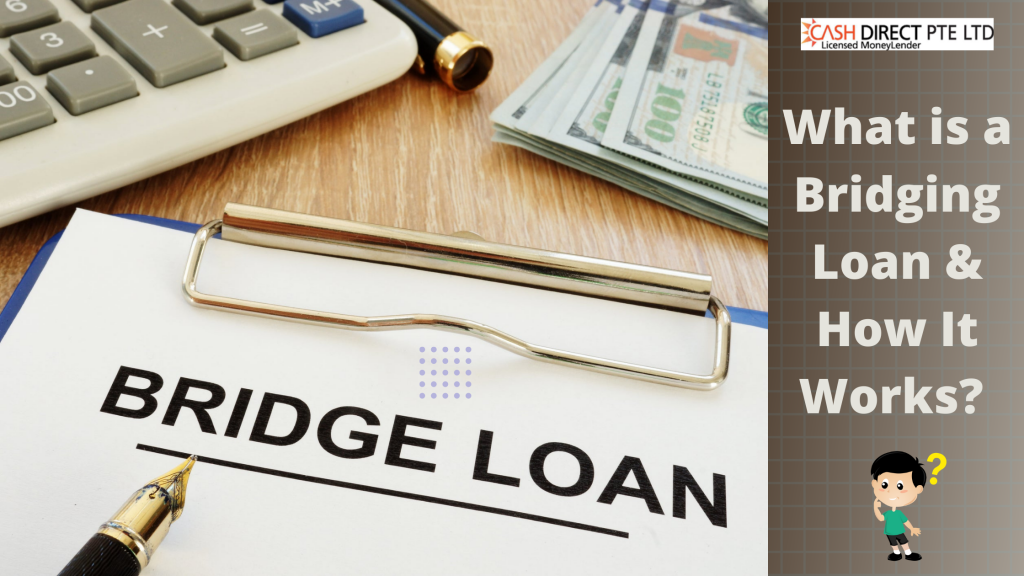After searching the real estate market, now, you have got an ideal dream house.
And, you want to crack this deal before someone else catches it.
But what if you have not also sold the house you already own with a mortgage?
One option that can be considered is a bridging loan to assist you to bridge the financial gap.
By choosing the bridging loan, you can determine the fixed payments that can raise funds and clear new and/or existing property.
In Singapore, the bridging loan is held by those who want to sell the old flats for downgrade or upgrade. This loan could be leveraged for the downpayment or different expenses associated with the property purchase.
The bridging loan is a short term loan designed specifically to meet the buying cost of the second property. Also, Provide you the time to market the current property (it is also probable when you have a mortgage already).
Essentially, it builds a financial bridge that permits the owners to cross the gap between selling and buying.
What is a bridging loan?
The Bridging loan is a short-term real estate mortgage finance. Certainly, these types of loans are usually used to provide you with funding for some time. While enabling you to sell the property or refinance long-term debt.
Getting a bridging loan is a daunting task. However, the popular online comparison websites are here to help you to compare these loans. And provide you the loan that best suits you and your requirements.
It is generally provided in between one to eighteen months with the condition that the loan should be repaid at the end of the mentioned term. As compared to the different borrowing forms, the monthly interest is usually blended in the loan. This means that there will not be any repayment to perform in the loan time period.
The process of application is generally simple and easy as compared to a different license money lender loan application . This borrowing types will finish promptly, normally in five to fourteen days. The bridging finances could be provided in every land or property and might be employed for many reasons. It offers many uses, some of them are:
- Repossession stoppage
- Purchasing property below the market value
- Purchasing an unoccupiable property
- Funding conversion work or property restoration
- Buying a property immediately, like, auction purchases
Despite the above mentioned, the bridging loan can also be leveraged for saving the end life of the elders by purchasing the senior life insurance policy. To get these types of policies, you can check the Seniors Life Insurance Finder.
Different types of Bridging Loans
In Singapore, you can apply for two Bridging loan types, Simultaneous Repayment Bridging Loans, and Capitalised Interest Bridging Loans.
Simultaneous Repayment Bridging Loan
You can anticipate obtaining payments on bridging loans and new home loans at one time, consequently “simultaneous”. It gives you a time period of twelve months, in which you need to repay the loan and sell the old property.
Conduct your own due diligence by monitoring different bank policies for bridging loans and housing loans. Like, some banks have some guidelines, like, how much money you can pay at once.
Capitalized Interest Bridging Loan
These loan types activate the repayments when the original property is being sold. Then, the Singapore loan company funded the overall amount of the new home.
The interest will be included in the whole term of the bridge loan. And you will pay the intact principal and the interest incurred.
First and second-charge bridging loans
When you get this type of loan, you will be charged a “fee” on the property. It is a contractual agreement that specifies which lenders will be refunded first if you do not repay the loan.
In the unlikely event that you default on repayment, both the first and second bridging loans will use your property as collateral.
Usually, if your home mortgage is however a mortgage, then the bridging loan will be the second mortgage. It implies that if you fail to fulfill the repayment and the house is sold to repay the debt, then the mortgage will be paid off at initial.
However, if you fully own your property, or you are using a bridge loan to refund the mortgage in full, then you will get your first loan. That is, if you default on repayment, then, the bridging loan will be repaid first.
Advantages and Disadvantages of Bridging Loans
Before locking any decision, it is essential to check out the advantages and disadvantages of the Bridging loan. The Singapore loan companies who provide these types of bridging loans list many advantages and disadvantages.
Advantages of Bridging Loans
The bridging loans assist in purchasing the property seamlessly without waiting to sell the current house.
According to how you structure the loan. In the breeding time frame, you must make the repayments on the existing mortgage.
When the timing is accurate with the sale/purchase and bridging loan. It is probable that you can evade the hassles and costs of renting a house in the time frame among the sale of the existing house and settlement of the new house.
Disadvantages of Bridging Loan
If you do not sell the house in the expected time period, you may face huge interest bills or risk the bank’s involvement in selling the house.
Risk of not marketing for a high price
If the price of your house is lower than your expectations, you may leave a large continuous loan amount. Which may dig you into economic trouble. It might be worth it to have a backup plan.
Bridging finance might need two property valuations; the new and the existing property. It includes two valuation fees, costs for the extra loan, and other fees.
Generally, it is charged monthly, and it takes longer than usual to sell the property, then, the more interest the new loan will tend to accumulate.
If you do not market the existing house in the breeding time frame, then, you will, basically, be charged a more interest rate.
If the existing Singapore loan company is not providing a bridging loan, then, you have to make a move to another one. The one that makes an early exit fee than the existing loan (Precisely, if you are changing in the fixed interest rate time frame).
Here, it is essential to check out the important fact sheets and additional loan documentation, and the guidelines before securing the decision of purchasing.
How does a Bridging loan work?
When it is about the bridging loan, it is essential to know how it works, and for that, there are some elements that need to be understood.
Check them out below:
One lender generally gives both loans
When the bridging loans are taken, the moneylender Singapore gives the money for buying the new property, also, takes the mortgage on the current property. Also, the lender can make amendments to the original loan status, like, providing you the choice of adapting the interest-only repayments or reducing the time period. Indeed, there will be some cost included in the overall process; like, charges or fees of loan alterations.
What you owe is termed as Peak Debt
“Peak Debt” usually defines the overall money taken from the lender for less time span of the bridging loan. Basically, it is measured by integrating what you want to acquire to buy the new house to the left mortgage on the current house. Like, in case, when you want to get $650,000 to purchase the new house and still, you have $300,000 on the existing mortgage, then, the peak debt will be $950,000.
In the bridging period, the repayments can change
The repayments integrate the payments on one or both loans (note down the guidelines of the bridging loan by the lender before registering).
While selling the existing home, the outstanding amount is termed as “End Debt” or “Outstanding Balance”
Then, subtract the possible selling price of the current house of the peak debt, leaving the “Ongoing balance” (that is, the total balance of the new loan). Like, if you hold the peak debt of $950,000 and market the current property by $500,000, then, the End Debt or Ongoing balance is $450,000.
After the selling process, the loan will return to the different product
When your mortgage on the original house, the bank may provide or ask that the loan be switched to another loan type, like, a standard term loan or a loan with principal and interest repayment. It is always a better idea to know what loan interest rates and conditions will be applied after the bridging loan time frame.
The new loan will have different repayments
The amount you need to pay the bank in the payments is differentiated to the repayments prior to taking the bridging loans and the repayments in the bridging time frame.
Specifications to have a Bridging loan
There are some specifications that you can apply to the bridging loans that are not meant for some other home loan types. According to the lender and some particular product you have, some of the considerations or criteria that can be applied are:
- Maximum LVR requirements:It means you require a deposit of some amount to apply. Few Singapore loan companies can also demand to have a less equity level in the existing home, like, on a 25% deposit, 20% of the peak debt.
- The highest loan term on the bridging loan, like, the existing home can be sold in six to twelve months.
- You cannot use the redraw facility on the bridging loan in the bridging term.
- The bridging loan cannot be accessible for the strata title purchase or company purchase.
Considerations before getting a bridging loan
There are some specifications that you can apply to the bridging loans that are not meant for some other home loan types. According to the lender and some particular product you have, some of the considerations or criteria that can be applied are:
- Maximum LVR requirements:It means you require a deposit of some amount to apply. Few Singapore loan companies can also demand to have a less equity level in the existing home, like, on a 25% deposit, 20% of the peak debt.
- The highest loan term on the bridging loan, like, the existing home can be sold in six to twelve months.
- You cannot use the redraw facility on the bridging loan in the bridging term.
- The bridging loan cannot be accessible for the strata title purchase or company purchase.
Several considerations are there that you cannot avoid before getting the bridging loan, find them out below:
Do not neglect the total cost
While contrasting the products from varied products, do not forget to consider the total loan cost, then only the interest rate. Usually, the users follow the interest rate, however, several lenders ask more exit fees, find some hidden or management fees.
Also, request for the breakdown of the total cost of getting the loan before starting the process. It is because of the manner of comparing the providers easily.
Is your repayment method feasible?
The major risk of a bridging loan is that you will not be able to return the loan at the end of the loan period. Prioritize how the loan gets repaid and assure that the proposed exit is feasible.
If you want to sell the property, assure that the loan term provides you enough time to get the buyer and for the sale to close.
If you intend to refinance a long-term loan, you must validate whether your application is likely to be acquired.
Whenever possible, before completing the bridge loan, try to reach an agreement in principle from the lender you choose.
Check if you are getting the best deal?
The cost difference between providers can be large. Also, few lenders can only be obtained via a higher number of brokers, which means you might not have entrance to the less interest rate.
What is the approximate cost of the bridging loan?
The bridging loans are charged on a monthly basis, instead of on a yearly basis. The reason lies in the fact the users like to get it for less time period.
The disadvantage of the bridging loan is that it is somehow expensive; the user can face a fee of around 0.5% and 1.5% per month.
This addresses them as more expensive than ordinary residential mortgages. The comparable annual interest rate (APR) for bridge loans is among 6.1% and 19.6%-much expensive as compared to the other mortgages.
You also need to consider the setup fee, which is ordinarily about 2% of the loan you need. Hence, it is recommended that you only withdraw the bridge loan when you are certain that you will not want the loan for a long time.
Also, request for the breakdown of the total cost of getting the loan before starting the process. It is because of the manner of comparing the providers easily.
Wrapping Up
This is all from our side!! If you have any queries or suggestions related to bridging loans, then you can ask us in the comment section below.
Thank you for reading!!




